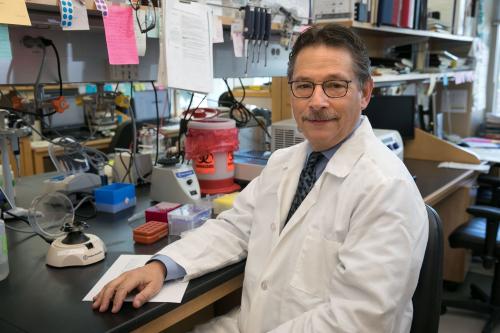
Curing 'bubble baby' disease: From the lab to the clinic
For the last several decades, scientists worldwide have been seeking to harness the power of stem cells to develop therapies for human diseases and conditions. At UCLA’s Broad Stem Cell Research Center, the potential to bring stem cell therapies to patients is now a reality.
One of the center’s researchers, Dr. Donald Kohn, has dedicated his career to understanding the genetic mutations that cause blood disorders. When he began this work 30 years ago, his ultimate goal was to create stem cell gene therapy treatments that take a patient’s own blood-producing stem cells and fix the broken genes to eliminate the disease-causing mutations and the associated debilitating symptoms.
Now Kohn’s pioneering work has reached that goal with three phase 1 clinical trials for genetic blood disorders currently underway. One of these trials targets Severe Combined Immunodeficiency caused by adenosine deaminase deficiency, commonly known as ADA-SCID or “bubble baby” disease, which is fatal if left untreated. The ADA-SCID trial has cured 23 out of 23 babies to date.
Recently, a new company called Orchard Therapeutics was formed to bring the stem cell gene therapy treatment for ADA-SCID to more patients. The gene correction method is an advanced technology that has, to date, only been available at UCLA. It’s hoped that UCLA’s collaboration with Orchard Therapeutics will expand physician access to the technology, allowing patients to remain close to home.
Kohn spoke to Mirabai Vogt-James of UCLA Health Sciences about the progression of his research from the laboratory to the clinic.
As a physician who treats patients, what motivated you to begin doing scientific research?
Many blood cell diseases can be treated successfully, or even cured, with a bone marrow transplant from a matched donor, but these transplants are complicated and most patients don’t have a perfectly matched donor. I began working on gene therapy as a fellow at the National Institutes of Health in 1985 and then began practicing as a pediatric bone marrow transplant physician in 1987. Seeing the transplant needs of patients go unmet because our current methods have limitations, and building on my interest in gene therapy, I was inspired to focus my scientific research on the goal of finding other options for patients with blood diseases.
What did it take for your research to reach this point?
It took three decades and lots of dedicated scientists and students in the lab, support from research funding agencies, philanthropists, faculty and collaborators at UCLA and other institutions, and support from the various departments I’m affiliated with, including significant support from the UCLA Broad Stem Cell Research Center and the Children’s Discovery and Innovation Institute at Mattel Children’s Hospital UCLA. We also benefited from a critical collaboration with the UCLA Office of Intellectual Property. The expertise and collaboration of the entire management group have been vital to our success. But ultimately, now that we’ve reached the clinical trial stage, we really have to thank the families who have put their trust in us. The families and patients who participate in our clinical trials have allowed us to show that this method is effective and can cure babies of a disease that would otherwise be fatal.
What is most significant about developing the technology?
Developing the gene therapy technology so that it can be used outside of UCLA will expand access and help us reach countless patients. Ultimately, this shows the growing maturity of gene therapy as a method for treating disease. I remember when we were asking ourselves, “How do we do this?” Now we’ve shown how it’s done and are talking about strategies for reaching more patients. This is the natural arc of things; academic medical centers show proof of principle for a method or drug and, if successful, then move that work to industry to make the therapy broadly available to patients. The most important aspect in all of this is now the stem cell gene therapy for ADA-SCID will be more readily available to help many more babies and their families. This is what we’ve been working towards all along.
What are your next research goals?
Our next step is to use a similar stem cell gene therapy for other blood diseases, such as sickle cell disease, which is the most common inherited blood disorder in the United States. The global impact of this disease affects millions, with 250,000 new patients worldwide each year. There is a great need for a new approach to treating this debilitating disease, but it is more challenging than ADA-SCID for a variety of reasons. My hope is that our current clinical trial for sickle cell disease, as well as the preclinical sickle cell research my lab continues to work on, will coalesce into a treatment that greatly improves, or even reverses the disease.
Kohn is a paid consultant on Orchard’s Scientific Advisory Board, and The Regents of the University of California have licensed intellectual property to Orchard.
In this video, Dr. Kohn discusses a method that uses a patient's own blood-forming stem cells and a gene editing technique to correct genetic mutations that cause blood diseases, such as sickle cell and “bubble baby” disease.
